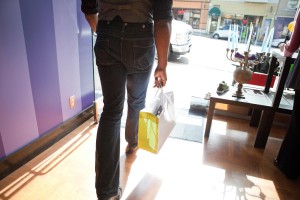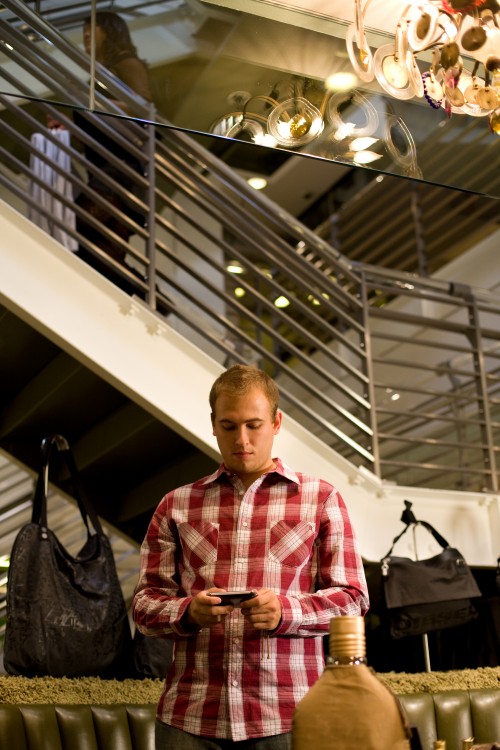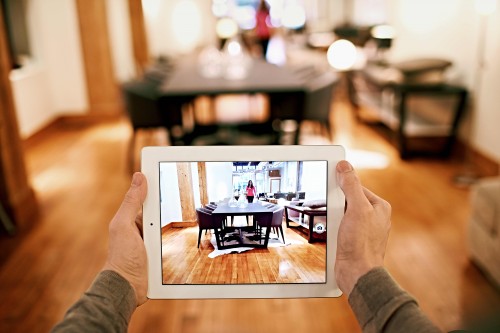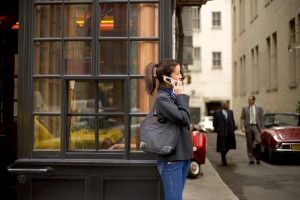
Here’s a guarantee – every single one of you reading this blog, shops. You may not enjoy it, but you shop.
Here’s another guarantee – the way you shop is about to change, thanks to the Internet of Things.
Technology is no newcomer to changing the face of retail. I am not even going to discuss shopping with our mobile phones or internet shopping here, because those things are now as normal to us as brushing our teeth in the morning. All I will say, is that the growth in these omnichannel revenues is exponential; 20% of us now buy something on our mobile device every single day, and more men (27%) than women (22%) shop online, although women are more likely to buy clothes online than men.
Partly this is because it’s just so easy to make a purchase, and partly it’s because it’s equally easy to make an impulse purchase. This is one reason why we spend 40% more when shopping in a store on our mobile devices than if we go into the same store in person. It’s also one of the contributing factors to the annual $90Billion of Amazon revenue. Just think how many times you made a purchase online at night from a mobile device, which you would have forgotten about by morning if you had had to wait till 10am when the store opened.
But your wireless smartphones and tablets are now much more of a tool for retailers than merely a means of transacting or browsing a store’s online website.
That’s basically because as consumers, we are a pretty easygoing bunch – in order to buy something, we don’t have to need it. We don’t even have to be able to afford it. All we have to do in order to make a purchase, is to want it.
(This is why a lady with 14 fairly similar little black dresses hanging in her wardrobe will walk into a store and buy another one. I don’t want to make generalisations, but ditto men and gadgets).
 So, for years, a number of tactics have been deployed by retailers to make us want something. Advertisers, for example, subliminally convince us we want a product because it will make us more rich, powerful, or attractive to the opposite sex.
So, for years, a number of tactics have been deployed by retailers to make us want something. Advertisers, for example, subliminally convince us we want a product because it will make us more rich, powerful, or attractive to the opposite sex.
Marketing make us want something by inflating the price of a product (Sali Hughes, Guardian beauty editor, blew the top off that one when she published that the only reason some face moisturizing creams cost £150 is because some women want to pay £150 for a face moisturizing cream), or they make it rare and create a waitlist (Hermes bag, anyone?), or they give one-off discounts, making it so cheap we can’t afford not to buy it.
So like I said, there is a long list of ways to encourage consumers to want a product. And now, you can add technology to that list. Starting with Location Analytics.
Products like Cisco CMX registers a person’s entry into a store or shopping mall just by the presence of a smartphone or tablet their pocket. Tracking shoppers’ routes around the store or mall, and thus identifying the busiest and best spots to place advertisements or special offers, thus becomes easy for the retailer.
But the real intelligence from location analytics comes when the shopper connects to the mall’s wireless network. Because then, not only does the retailer know the location of their shopper, they also know their behaviours, shopping history and preferences. Connection with Facebook, for example, will tell the retailer the demographic and interests of the shopper – thus enabled targeted, bespoke and effective advertising. One minute a 35-year old married lady with a newborn baby who has been surfing vacation spots online lately walks by, and the digital sign advertises a promotion on baby products, or on family vacations in Greece. The next minute an 18 year old who is about to leave home for University walks past the same spot, and the exact same digital sign immediately switches to an advertisement for Abercrombie & Fitch clothing or a promotional offer for study materials.
Hence, the quote often attributed to John Wanamaker, that “Half of the money he spent on Advertising was a waste of money; he just didn’t know which half” no longer applies. Advertisers and media giants no longer need to bombard us with advertisements in order to capture their market. They can target relevant ads right at us.
When speaking to large audiences about this capability, I often get the question about personal privacy, which they feel gets lost when a retailer has this much access to this much information through our smart device. My only answer is that the concern varies by generation – in a recent survey Cisco conducted, 91% of Gen Z respondents under the age of 25 told us they were happy to give away all of their mobile phone and social media data in order to get personalized offers.
Similarly, an entire mall provider can ‘see’ the behaviours of different demographics and make better use of their real estate. For example, lets say that there is a particular seating area where bored husbands sit on a Saturday afternoon while their wives continue searching for that 15th little black dress (oh come on, we’ve all seen them). From the analytics, the mall recognizes it’s a place where groups of males are stationery for extended periods of time, and can therefore choose that as the perfect place to put a TV screen and a beer stand (oops, there I go again with my generalisations).
And  when we are not stationery, but actually shopping, location sensors like iBeacon show our location with such accuracy that stores can not only see what store we are in, but what products we are perusing. If we are connected to the mall wifi network, they can then also know if we go to a price comparison site and automatically send a discount voucher to our phones for purchases of that product made in store that day.
when we are not stationery, but actually shopping, location sensors like iBeacon show our location with such accuracy that stores can not only see what store we are in, but what products we are perusing. If we are connected to the mall wifi network, they can then also know if we go to a price comparison site and automatically send a discount voucher to our phones for purchases of that product made in store that day.
Shopping mall provider, INTU, receive over 400 million customer visits a year. Having deployed the CMX technology, they are provided with a huge volume of anonymous big data analysis which enables them to better know and predict their customers’ needs. Using an anonymous heatmap to track their customers’ routes in the store, they were able to see the increase in footfall for certain events and thus know what increases their customers’ satisfaction and experience in the mall.
It’s easy to see, therefore, why using existing technology – like CMX , WiFi and social media – increases the effectiveness of omnichannel by informing the brand of our purchase patterns, website visits, loyalty programs, and other data mining techniques.
But all of that is available today. And it’s the tip of the iceberg in terms of the opportunities coming to consumer retailers as a result of the Internet of Things (IoT).
First, the Internet of Things is a big aid to those stores suffering from store employees no longer being the trusted advisor. It’s now often the case that we know more about the product we want to purchase than the staff do. One example of this is bookstores – Independent bookstores used to be the font of all knowledge, but these days, it’s often Amazon who provide better book recommendations based on our previous purchases and those of other, similar Amazon customers.
With the IoT, the store can begin to understand what we want, perhaps even before even we do. (And remember, if a retailer can make us want something, their job is almost done).
Lets say, for example, that lady above books that beach vacation in Greece. Thanks to the IoT, Big Data and the Cloud, the local pharmacy can position a commercial for sun lotion on the digital sign when she walks in, the nearest bookstore can send her an offer for 2-for-1 on beach reads, and an online swimwear outlet can send her their link for this season’s bikinis.
Connecting the store, and everything within it, to the internet will also make a big impact on our shopping experience. Right now, 20% of headcount in a grocery store is working at the front of store, where it adds little value. Smart shopping baskets, with the basket and contents and customer loyalty card all connected to the internet, would remove that inefficiency and instead enable those staff to be utilized for more knowledge-based work in the store instead.

Paper price tags are also a thing of the past. The cost of electronic screens is now so low that within just a few years we can expect to see almost all vertical surfaces in a store covered in them. Which means that pricing of any item can be changed in real time based on demand or based on the profile of the customers entering the store (which we know, because of CMX remember), rather than being fixed. This means shops can capitalize on opportunities to increase prices for the same product, or offer promotional pricing to increase sales, on a minute-by-minute basis, without any human intelligence or interaction being needed.
Store shelves will also be so much more valuable when they are connected to the internet. A store in the US deployed them in the freezer section, along with digital signage and price labels. Whenever a tub of ice cream was removed from the shelf, the nearest digital sign immediately displayed a promotional offer on fudge sauce. Sales of fudge sauce during the trial period increased by 80%.
The real benefit of the IoT for retail though, comes from the M2M capabilities. Here at Cisco, we visit schools in the local area to advise them about careers in IT. On recent visits, we have been doing fun exercises with them where we asked them to give us their ideas of what they would most like to have connected to the internet. One of the most popular ideas we receive from the children is that they would like to connect the ice lollies in their freezer at home to the internet, so that when they took the last one, ice lollies automatically got added to their Mother’s shopping list.
 The kids were really onto something, but they just weren’t thinking big enough (to be fair, they are only twelve). Because when the fridge at home is connected to the internet, and the ice lollies in it are connected to the internet and the shelves in the supermarket are connected to the internet and the Mother’s loyalty card is connected to the internet, they can all talk to each other. Which means that the Mother won’t need to write a shopping list – the store already knows which products she is out of. And the store has already stocked up on those products the day before she usually comes into the store.
The kids were really onto something, but they just weren’t thinking big enough (to be fair, they are only twelve). Because when the fridge at home is connected to the internet, and the ice lollies in it are connected to the internet and the shelves in the supermarket are connected to the internet and the Mother’s loyalty card is connected to the internet, they can all talk to each other. Which means that the Mother won’t need to write a shopping list – the store already knows which products she is out of. And the store has already stocked up on those products the day before she usually comes into the store.
Which brings us to the second thing a retailer needs in order for us to make a purchase with them, after having confirmed that we want it…… They need to have it in stock.
That seems obvious, but 17% of the time we enter into a shop and can’t buy the product we want because they don’t have it, so we either leave empty-handed or with a compromise. So having more elements of our lifestyle connected to the internet is a big advantage to these stores, because they can predict what we will want in the near future, and they don’t miss out on that 17% of revenue. Equally, it’s a big advantage to the kids at home who don’t ever again have to look in the freezer for a strawberry ice lolly and find that the store only had vanilla (which I think we can all agree is one of life’s big disappointments when you’re 12).
You may say “That’s just ice lollies”. To which I would respond that in Britain we spend £1.1Bn a year on ice cream, but more importantly, it’s not just ice lollies. When you extrapolate that up to the whole £1.7Bn a year we spend in grocery stores in Britain, then take it even further to all of the retail products we purchase in all of the stores, you can see it does make a big difference to retail revenue.
It also reduces waste and increases the environmental efficiency of products. Because when the products we buy from the shelves are also connected to the internet – right from the start of their journey in the ground or manufacturing plant – then consumers can verify that a product really is organic, or that it really is ethically sourced, and can know really how old it is, thus making sell by dates more realistic and avoiding the unnecessary disposal of food which has passed it’s sell-by date but is actually perfectly fine.
This is how the IoT will radically change our purchasing patterns and shopping experience. Stores will be able to provide us with an intuitive shopping experience; they will once again become the trusted advisor; they will be able to predict what we will want and be ready to give it to us when we want it, in the flavour/colour/style/size we want it. It will improve retailers revenue, reduce return rates and lead to less waste.
At the same time, it will lead to greater satisfaction for consumers, and make shopping an easier and more enjoyable experience. Which has got to be a good thing, because as I said at the beginning, everyone shops. But in the future, a few more of us might actually enjoy it.
10 Comments
Cisco survey found under 25s to be keen to give up their data. Funny that. I have seen survey data that says 71% don’t like the idea of being snooped on. Which is more likely to be unbiased. A tech company called Cisco? Oh…
Interesting. But sometimes I like to do my own comparisons on prices. Keeps the brain cells working at age 76
Smart phones, smart houses and smart cars all integrated are the future so that as the last of the milk is taken out of the fridge the home PC contacts the store and orders more, the payment is made automatically and Mum received a text to either call and pick it up on her way home or arrange for delivery. That is the tech being developed at MMU.
Absolutely fascinating and am so amazed this hasn’t already been implemented. I’m a devotee before it’s even arrived – love it
Very interesting article.
Can’t stand advertising as it is! Guess I’ll have to switch my phone off when shopping.
Thanks – an interesting article!
This article stops short of suggesting how the IoT can really serve the consumer. Let’s remain with the analogy of the ice cream in the freezer, this article suggests the local store will know to stock up on your particular flavours the day before you would normally shop.
Why would it not be the case that the IoT would not raise an on-line order at the end of a week that targeted the best deals from all the major grocery retailers so that instead of going shopping, your groceries were deliverered not from one provider but from the providers of the best beat deals, therefore covering the coat of delivery via the savings made and also providing a just in time shopping experience that really works for the consumer
stationEry is envelopes, paper and pens
StationAry is what people are when they stop moving
I think you have missed the point of the article.